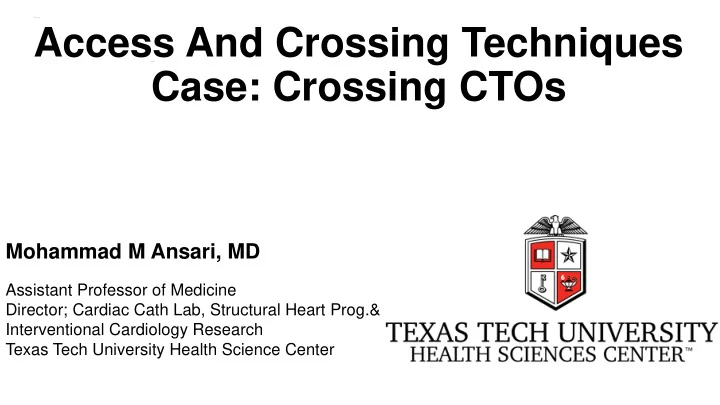

Access And Crossing Techniques Case: Crossing CTOs Mohammad M Ansari, MD Assistant Professor of Medicine Director; Cardiac Cath Lab, Structural Heart Prog.& Interventional Cardiology Research Texas Tech University Health Science Center
Disclosures: • Bard Peripheral Vascular – Research, Consultant, Speaker • Abbott – Research, Consultant • Medtronic – Consultant • Cordis – Consultant, Speaker • Philips – Steering Committee, Consultant • Boston Scientific – Advisory Board, Consultant, Research • Ra Medical – Consultant • Asahi – Consultant • Edwards- Speaker • Gore- Consultant, Speaker
Outline: Chronic Total Occlusion Crossing Approach Based on Plaque Cap Morphology: CTOP • Stating the problem • CTOP Classification • CTOP Findings • Practical Applications
Stating the Problem • Chronic Total Occlusion rates range any where from 50-60% (PRME Registry) • Failure rates in crossing CTOs have ranged from 20% to 40% • Most operators do not attempt retrograde tibiopedal access unless a traditional attempt to cross the CTO in antegrade fashion has already been pursued. • This “traditional” approach provides a false sense of security and could arguably be harmful in some instances given that after a failed antegrade attempt most physicians tend to stop and reschedule the patient for another procedure. • This predisposes the patient to another hospitalization, puncture, potential exposure to anesthesia, and other inherent complications.
PRIME Registry • The Peripheral Registry of Endovascular Clinical Outcomes (PRIME Registry) • Multi-center observational registry with 3-year follow up • Inclusion: Rutherford Class III-VI subjects undergoing PVI • First subject enrolled Jan 2013 • Currently > 900 subjects enrolled at 5 centers
Chronic Total Occlusion Crossing Approach based on the Plaque Cap Appearance. The C-TOP Trial • Retrospective analysis evaluating CTO CAP morphology. • Analysis of 114 patients enrolled in the PRIME registry with 142 CTO’s • Prevalence of different CTO caps • Access selection, technique and success rate of crossing
Plan a CTO Crossing Define CTO ,Length Proximal Cap Distal Cap Access Selection Antegrade Dual Retrograde Crossing Antegrade Crossing Retrograde Crossing Advanced Techniques Revascularization Strategy Atherectomy DCB Stent
C-TOP classification 29.4% 14% 20% 36.6% Saab et al
CTO Distribution: CTOP� Type� vs� Vessel� Location� � Total� Type� I� Type� II� Type� III� Type� IV� n=� 142� n=28� n=52� n=20� n=42� � � � � � � 50.7%� 11.1%� 43.1%� 12.5%� 33.3%� SFA� (72/142)� (8/72)� (31/72)� (9/72)� (24/72)� � � � � � � � 18.3%� 42.3%� 19.2� %� 23.1%� 15.4%� Pop� (26/142)� (11/26)� (5/26)� (6/26)� (4/26)� � � � � � � � � 31%� 20.4%� 36.4%� 11.4%� 31.8%� AT/PT� (44/142)� (9/44)� (16/44)� (5/44)� (14/44)� � � �
Access� Data� � � Type� I� Type� II� Type� III� Type� IV� n=28� n=52� n=20� n=42� Pedal� 0%� 16.0%� 8.0%� 76.0%� � (0/25)� (4/25)� (2/25)� (19/25)� 17.6%� � � (25/142) � � 40.4%� 36.5%� 5.8%� 17.3%� Antegrade� � (21/52)� (19/52)� (3/52)� (9/52)� 36.6%� Access� (52/142) � � Dual� 0%� 42.9%� 33.3%� 23.8%� � (0/42)� (18/42)� (14/42)� (10/42)� 29.6%� � (42/142)� Retrograde� � � � � CFA� 30.4%� 47.8%� 4.3%� 17.4%� 16.2%� (7/23)� (11/23)� (1/23)� (4/23)� (23/142) � Access� 24.6%� 0%� 42.9%� 20%� 37.1%� (35/142)� (0/35)� (15/35)� (7/35)� (13/35)� Conversion � �
Lesion� Characteristics� � � Type� I� Type� II� Type� III� Type� IV� n=28� n=52� n=20� n=42� � � � � � Non� Severe� 34.3%� 35.7%� 4.3%� 25.7%� 49.3%� Calcium� (24/70)� (25/70)� (3/70)� (18/70)� Density� (70/142)� � Severe� � � � � 5.6%� 37.5%� 23.6%� 33.3%� 50.7%� (4/72)� (27/72)� (17/72)� (24/72)� (72/142)� � � � � � � Avg� Lesion� Length (mm) � 236.5� 127.9� 277.7� 259.5� 246.8� �
Advanced Techniques/Re-Back Technique • Re-entry using ante grade outback device • The Outback needle is used to puncture a retrograde balloon • Utilized if antegrade and retrograde wires/catheters are in two different sub-intimal planes
Superior control with antegrade access
- Type III CTO - Longer than 10 cm - High likelihood of subintimal crossing - Re-entry may occur beyond re- constitution - Retrograde access will preserve relatively normal segments
• Wire advanced into the balloon Balloon pulled distally Wire advanced from one sub- intimal space to another Deliver treatment from true lumen to true lumen
Predictors of Crossing Direction Type I ------Antegrade Type IV ------Retrograde
Type II & III Lesion Length >10 cm Severe Calcification
CTO CTO (long Short(<10 cm), >10cm), Severe Non severe Ca Calcification Antegrade CTOP Type Crossing Type I Type II Type III Type IV traditional CFA Dual Access Dual Access Pedal Access access
Does it work????? • 73 year old female with CLI, RF class V • ADT to the R AT distribution • CFA endarterectomy (3 weeks prior) • Referred by VS for final tibial therapy
Type II
Technical Evaluation….??? • What vessel should we access, L CFA??? • Is it possible perform antegrade Prepare For Pedal access??? • CTO device ??? Access?? • What size sheath??? • CTO wire VS. Work horse Wire??? • Start with Antegrade Crossing???? • If failed…Bring back? • Start with Pedal Access???
Lets See What Happens……!!!!!
Did we Cross??? -Advance the wire further???? -Advance a Supporting catheter??? -Inject Contrast
Wire meeting distal CTO Distal Deflection Saab et al
Saab et al
Sub Intimal Wire Confirmation…..!!!!
Foot Prepared….!!!!
Tunneling!!!!
Access to Tunneling : 3 min 45 sec VS. Access to Subintimal : 6 min 36 sec
Conclusion: • CTOP is the first trial to categorize CTO’s in a simple, easy to apply process • Lesion length, Calcium content and CTO types II & III are the major predictors of access conversion • The implications for technical success are significant exceeding 98% of cases. • There are potentially time savings and increase in safety profile • Starting with pedal access may be potentially the standard of care as experience is gained among operators
Recommend
More recommend